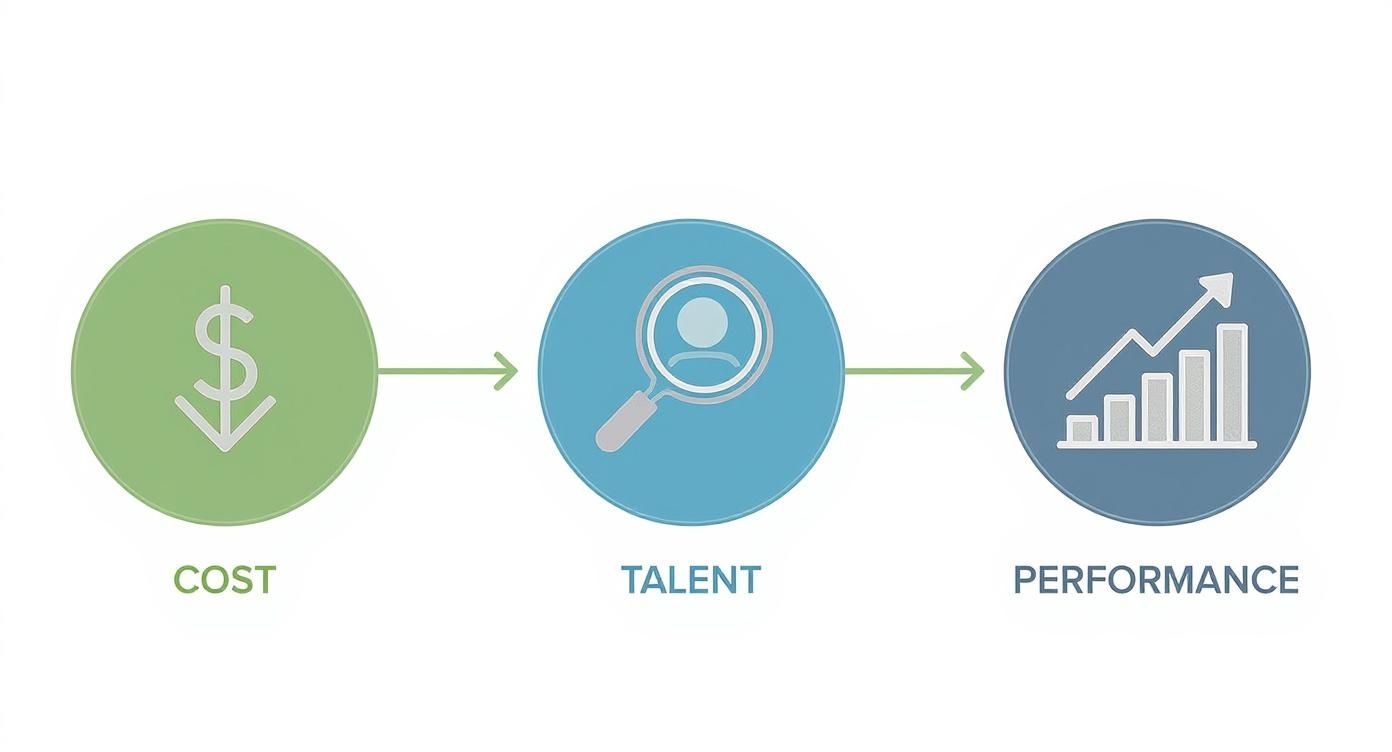A Complete Guide to Employee Aptitude Testing

What if you could see a candidate's potential for success before you even hired them? That’s the real power behind employee aptitude testing. These aren't just quizzes; they're tools that look past a polished resume to measure a person's raw cognitive abilities, their knack for problem-solving, and their natural capacity to learn and adapt.
Understanding The Power Of Aptitude Assessments

Think of aptitude tests as the great equalizer in hiring. They shift your decisions from the shaky ground of gut feelings to the solid foundation of objective data. Instead of just taking a candidate's CV at face value, you get to evaluate their fundamental ability to think, reason, and tackle new challenges.
It's a lot like a combine for professional sports. You're not just looking at a player's past stats; you're measuring their raw speed, agility, and strength to predict how they'll perform on your team. This data-driven approach creates a fair and standardized benchmark, ensuring every single candidate is measured by the same yardstick.
Why It's A Game-Changer For Hiring
Let's be honest, traditional hiring methods can be a minefield of unconscious bias. An interviewer might unconsciously favor a candidate who went to the same university or shares a similar hobby, completely overlooking someone who is far more qualified for the job.
Aptitude tests cut through all that noise.
By zeroing in on measurable, job-relevant skills, you get a much clearer picture of who can actually excel in the role. This is why aptitude testing isn't just a trend; it's a core strategy for the world's leading companies. In fact, research shows a significant portion of large companies, including over 80% of Fortune 500 companies in the US and a large number of FTSE 100 firms in the UK, use psychometric or aptitude tests in their recruitment processes (S. M. Colarelli et al., Personnel Psychology, 2002; High Fliers Research, The Graduate Market in 2019).
Making this shift toward objective measurement delivers some serious benefits:
- Higher Predictive Accuracy: Studies by industrial-organizational psychologists like Frank L. Schmidt and John E. Hunter have shown that cognitive ability tests are among the strongest predictors of future job performance across various roles.
- Reduced Bias: They create a genuinely level playing field for all applicants, regardless of background.
- Improved Retention: Hiring for aptitude means you find people who are a natural, long-term fit for the role and its demands.
The big idea here is hiring for potential, not just pedigree. It’s about focusing on what a person can do for your company, not just what they've already done.
Aptitude Testing vs Traditional Hiring Methods
To really get a feel for why aptitude testing is so effective, it helps to see how it stacks up against the old-school methods. While a resume and interview can tell you about a person's experience and how they present themselves, an aptitude test reveals their underlying cognitive horsepower.
This table breaks down the key differences.
Aptitude Testing vs Traditional Hiring Methods
| Hiring Metric | Traditional Methods (CV, Interviews) | Aptitude Testing |
|---|---|---|
| Objectivity | Highly subjective and prone to bias | Standardized and objective |
| Predictive Accuracy | Moderate to low for job performance | High for job performance and trainability |
| Focus | Past experience and self-reported skills | Innate abilities and future potential |
| Efficiency | Time-consuming (manual screening) | Highly efficient for large applicant pools |
| Candidate Insight | Reveals communication and interpersonal skills | Uncovers cognitive and reasoning skills |
The bottom line is that each method provides a different piece of the puzzle. Traditional methods are great for gauging personality and communication, but aptitude tests give you hard data on a candidate's ability to learn, reason, and perform. For a deeper dive into another type of assessment, you can explore our guide on what is psychometric testing.
A Look at the Main Types of Aptitude Tests

When you start exploring employee aptitude testing, you quickly realize it’s not a one-size-fits-all game. Think of it like a mechanic’s toolbox—you wouldn’t grab a wrench to fix a wiring problem. Each test is a specialized tool, built to measure a specific ability. The key is picking the right one for the job you need to fill.
Using the wrong test is like asking a brilliant graphic designer to build a complex financial model. You’re not giving them a fair chance to show you what they can do, and you’re not getting the information you actually need. To hire smarter, you have to understand what each type of test really tells you about a candidate.
The world of aptitude tests can be broken down into a few key categories. Each one gives you a different piece of the puzzle.
Cognitive Ability Tests
Let's start with the big one: cognitive ability tests. These are designed to measure a candidate's mental horsepower—how they think, learn, and solve problems. They are often fantastic predictors of job performance across all sorts of industries because they get to the heart of how someone processes information.
These tests usually zero in on a few key areas:
- Verbal Reasoning: Can the candidate understand and interpret written information? This isn't a grammar pop quiz; it’s about their ability to read a passage and draw logical conclusions from it.
- Numerical Reasoning: This looks at how well a person can work with numbers, charts, and data to solve problems. It's a must-have for roles in finance, analytics, or engineering where people live and breathe data.
- Logical Reasoning: Often using abstract shapes and patterns, this test measures pure problem-solving ability. It shows you if a candidate can spot rules and make connections between ideas without needing any prior knowledge.
For instance, a numerical reasoning question might show a sales chart and ask a candidate to calculate the percentage growth between two quarters. It's a direct, practical test of a skill they’d use on the job.
Situational Judgement Tests
While cognitive tests measure raw intelligence, Situational Judgement Tests (SJTs) get at something just as vital: practical, on-the-job wisdom. These assessments put candidates in realistic but hypothetical workplace scenarios and ask them what they’d do.
SJTs are incredibly useful for any role that demands strong people skills, sound judgment, and the ability to navigate tricky team dynamics. They give you a sneak peek into how a candidate makes decisions and handles the everyday challenges of a job.
An SJT for a customer service role might describe an angry customer demanding a refund well past the return date. The candidate would have to choose the best and worst ways to handle it, revealing their approach to conflict and customer care.
These tests are so effective because they move beyond theory and put people right into the context of the work. It's no surprise that a report by the Society for Human Resource Management (SHRM) found that 82% of companies use some form of pre-hire assessment, with SJTs becoming more common because of their real-world feel. For a closer look at what these look like, check out these examples of psychometric tests.
Role-Specific Skills Tests
Finally, you have tests for the hard skills. These role-specific skills tests aren't about general aptitude; they're about verifying that a candidate can actually do what their resume says they can do. It’s the most straightforward way to confirm their technical expertise.
A few common examples include:
- Coding Tests: Essential for software developers to prove their chops in a particular programming language.
- Writing and Editing Tests: A must for anyone in a content creation or marketing role.
- Mechanical Comprehension Tests: Used for technical and engineering positions to gauge understanding of physical principles.
By mixing and matching these different tests, you start to build a truly complete picture of a candidate. You see their cognitive horsepower, their practical judgment, and their proven skills. This layered approach is how you move beyond guesswork and make hiring decisions based on solid, objective data.
Why Aptitude Testing is a Smart Business Move
Bringing aptitude tests into your hiring process isn't just a trendy HR tactic—it's a core business strategy with a real, measurable payoff. The benefits go way beyond finding a good candidate; they touch your bottom line, your team’s efficiency, and the long-term health of your company. Simply put, employee aptitude testing turns hiring from a gut-feel guessing game into a data-backed science.
This calculated approach delivers results you can actually see. According to Allied Market Research, the global pre-employment testing market, valued at $2.5 billion in 2022, is on track to hit $7.5 billion by 2032. That growth is fueled by companies realizing these tools make hiring more accurate and efficient. If you're curious about the numbers behind this trend, you can learn more about the pre-employment testing market.
This isn't just about spending money on tests; it's an investment in building a stronger, more capable team. Let’s break down exactly how.
Cut Costs by Avoiding Bad Hires
We’ve all felt the pain of a bad hire. The U.S. Department of Labor has estimated that the average cost of a bad hire can be up to 30% of that employee’s first-year salary. That’s not just lost wages; it’s wasted time in recruiting, onboarding, and training, not to mention the hit to team morale and productivity.
Aptitude tests act as a powerful first line of defense, drastically cutting the risk of making that costly mistake. By getting an objective look at a candidate's cognitive skills and how they tackle problems, you get a solid indicator of how they'll perform on the job. This insight helps you make sure the person you bring on has the raw ability to succeed, which means less early turnover and less money down the drain.
A bad hire is like a slow leak in your company’s budget—it drains resources quietly but consistently. Aptitude testing helps you patch that leak before it starts by ensuring you bring the right people on board from the very beginning.
This kind of smart screening frees up your team to spend their valuable time interviewing candidates who don’t just have a polished resume, but who also have the proven potential to be a star performer.
Boost Retention and Performance for the Long Haul
Nothing kills momentum like a revolving door of employees. When you hire for aptitude, you’re not just plugging a hole in the org chart. You’re matching a person’s natural talents to what the job actually demands, day in and day out. That alignment is the secret sauce for genuine job satisfaction.
When people are in roles that fit their natural abilities, they feel competent, engaged, and rightfully challenged. This directly leads to:
- Higher Productivity: They pick up new tasks faster, solve problems on their own, and don’t need nearly as much hand-holding.
- Deeper Engagement: Work feels less like a chore and more like a place to shine, which keeps motivation high.
- Longer Stays: When you’re good at your job and you enjoy it, you’re far less likely to start scrolling through job boards.
Think about it: you wouldn't ask a natural-born sprinter to run a marathon. Aptitude tests help you put people in the right race, creating a high-performing team that wants to stay and grow with you.
Build a Fairer, More Diverse Team
Let's be honest—unconscious bias is a huge roadblock to building a diverse workforce. Traditional hiring methods, like sifting through resumes or unstructured interviews, can easily let biases about a person's name, school, or background creep in and influence decisions.
Employee aptitude testing cuts through all that by providing a standardized, objective baseline. Every candidate gets the same test under the same conditions, so the results are all about pure skill and potential. This focus on merit helps you:
- Sidestep Unconscious Bias: Decisions are guided by hard data, not just a gut feeling.
- Create a Defensible Process: Using a standardized tool gives you a clear, fair, and justifiable reason for your hiring choices.
- Discover Hidden Talent: You start to find incredible candidates from non-traditional backgrounds who have all the right skills but might have been overlooked in the past.
When you build your hiring process on a foundation of fairness, you don't just protect your company—you build a richer, more innovative team that truly reflects the world we live in.
How to Implement an Effective Testing Program
Launching an employee aptitude testing program doesn't need to be a massive, complicated undertaking. With the right framework, you can get it up and running smoothly, creating a process that's fair for candidates and incredibly insightful for your team. The goal here is to build a system that slots right into your existing hiring process and gives you reliable data you can actually use.
Think of it like building a high-performance engine for your recruitment machine. Every part has to be chosen carefully and put in the right place for it to run without a hitch. A poorly designed program just creates headaches for everyone, but a great one powers smarter, faster hiring decisions.
Define Your Core Competencies First
Before you even think about looking at a single test, you have to know exactly what you’re measuring. What does a successful person in this specific role actually do? Is it about solving problems on the fly, having an eagle eye for detail, or making sense of complex data sets?
Your first move should be to sit down with department heads and some of your top performers in similar roles. Together, you can map out a "success profile" for the position. This profile is your blueprint—it details the essential cognitive skills someone needs to not just do the job, but to excel at it.
- For a Financial Analyst: You’d be looking for top-notch numerical reasoning and sharp, logical problem-solving skills.
- For a Content Marketer: Strong verbal reasoning and the ability to think critically would be at the top of your list.
- For a Project Manager: You’d want a mix of logical reasoning and situational judgment to navigate tricky timelines and team dynamics.
Honestly, this first step is the most important one. If you don't have a clear target, even the best tests are just noise. Getting this right ensures you pick assessments that directly measure what predicts real on-the-job performance.
Select the Right Tests for the Role
Now that you have your success profile, you can start picking the right tools for the job. Not all aptitude tests are the same, so the key is matching the assessment to the specific competencies you've identified. Using a generic test for a specialized role is like trying to fix a watch with a hammer—it's the wrong tool and will probably do more harm than good.
As you build out your testing process, it’s worth looking at different platforms, including how you can be leveraging online quiz makers that offer more than just simple Q&As. A solid strategy often involves a mix of different assessments. For a deeper look at your options, check out our complete guide to pre-employment assessment tools.
Integrate Testing into Your Hiring Workflow
Where you place aptitude tests in your hiring funnel is a big strategic decision. It affects your efficiency and the experience candidates have. Put them too late in the process, and you’ve wasted hours on unqualified people. Put them too early, and you might scare off great talent before they even get a chance to shine.
So, what's the sweet spot? For most companies, it's right after the initial resume screen but before the first interviews. In fact, a 2014 survey by SHRM found that around 40% of organizations use assessments to screen applicants before the interview stage.
This placement works as a powerful, unbiased filter. It makes sure your hiring managers only spend their valuable time with candidates who have already shown they have the core cognitive skills to succeed.
This kind of strategic sequencing lets you sift through a large applicant pool efficiently while keeping the process fair and data-driven right from the get-go.
This infographic lays out how a well-implemented testing program leads to clear business wins.

As you can see, by objectively pinpointing top talent early on, organizations can cut down hiring costs and, ultimately, see a real lift in overall team performance.
Communicate Clearly and Interpret Results Holistically
Finally, it’s crucial to remember that an aptitude test is just one piece of a much larger puzzle. Never, ever make a hiring decision based on a test score alone. The results should be used to add color and context to other evaluation methods, like structured interviews, portfolio reviews, and reference checks—not replace them.
Be upfront with your candidates about the process. A simple heads-up on why you use assessments and what they should expect goes a long way in building trust. This simple step creates a positive experience, even for those who don't end up moving forward. When you're reviewing the results, treat them as conversation starters for the interview, which helps you build a more complete and fair picture of every person you speak with.
Using Test Data to Bridge the Skills Gap
So, you've run a round of employee aptitude testing and discovered that very few candidates are hitting your ideal benchmark. It’s easy to look at this as a dead end, but I see it differently. This isn't a hiring failure; it's a strategic opportunity.
Instead of just using these tests as a simple pass/fail gate, think of them as a powerful diagnostic tool for your entire talent pipeline. This reframes your entire testing program from a basic filter into a sophisticated compass. It points you directly to the specific skill deficits popping up not just in one or two people, but across your applicant pool as a whole. That kind of insight is pure gold.
Let's be real: finding perfectly skilled candidates "off the shelf" is getting harder every day. The global skills gap is a massive challenge. ManpowerGroup's 2023 Talent Shortage survey found that 77% of employers globally report difficulty filling roles. This aligns with findings from the World Economic Forum, which has consistently identified skills gaps as a major barrier to economic growth. You can see how these trends are reshaping the hiring world by checking out a 2025 hiring reality check.
Pinpointing Specific Development Needs
When you step back and look at the test data in aggregate, patterns will start to jump out at you. You might find that while most of your applicants are great at verbal reasoning, they consistently stumble when asked to interpret numerical data. Or maybe their logical problem-solving is top-notch, but their situational judgment in team scenarios is shaky.
This is invaluable intelligence. It tells you exactly where your future hires are going to need the most support to really thrive.
By identifying these common weak spots before someone even joins your team, you can design targeted onboarding and training programs that address real needs from day one. You're no longer guessing; you're building a development plan based on hard evidence.
This proactive approach allows you to bridge the gap between a promising candidate's current skills and their full potential.
Building a Stronger Onboarding Experience
A data-informed onboarding process is light-years more effective than a generic, one-size-fits-all program. Armed with these insights from your aptitude tests, you can craft a custom experience that gets right to work on closing identified skill gaps.
- Targeted Training Modules: If tests show a general weakness in data analysis, you can build a specific training module on that very topic into everyone's first 90 days.
- Strategic Mentorship Pairing: You can match new hires with seasoned employees who are rockstars in the areas where the newcomer needs to grow.
- Customized Project Assignments: Give them initial projects that help build confidence and skill in their weaker areas, all under the guidance of a supportive manager.
This doesn't just get a new hire up to speed faster; it shows them you're genuinely invested in their professional growth from the very beginning. Understanding these gaps is the first step, and modern tools offer new ways to address them. For example, you can explore options like a webinar on AI simulation for closing the skills gap to see how technology can help.
Ultimately, using employee aptitude testing this way shifts your entire mindset. You move from just screening candidates out to strategically developing them in. You build a more resilient, capable workforce by recognizing that potential isn't a fixed trait—it's something you can nurture with the right support and insight. Your hiring process becomes the first, crucial step in a continuous, data-driven talent development cycle.
Common Questions About Employee Aptitude Testing
As employee aptitude testing becomes a go-to tool for modern hiring, it’s only natural for questions to pop up from both hiring managers and candidates. Getting ahead of these concerns is the best way to build trust and make sure everyone involved has a clear, positive experience.
Let’s tackle some of the most common questions and clear the air.
Are Aptitude Tests Fair to All Candidates?
When they're built and validated the right way, aptitude tests are actually one of the most objective tools you can have. They cut through the noise by focusing on what a person can do, not where they come from, which helps sidestep the unconscious bias that can easily creep into resume screenings and unstructured interviews.
A professionally designed test measures skills, not background, which levels the playing field for everyone. The key is to use assessments that are culturally neutral and fully compliant with all legal hiring standards to ensure true fairness.
How Predictive Are Aptitude Tests of Job Performance?
Decades of research, including a landmark meta-analysis by Schmidt and Hunter (1998), have shown that general cognitive ability tests are among the strongest predictors of on-the-job success across a wide variety of roles. In many cases, they’re a better indicator than interviews, years of experience, or even educational attainment.
That said, their real magic happens when you use them as part of a bigger picture. Combining objective test scores with structured interviews and real-world skill demonstrations gives you a much more complete and accurate view of a candidate. You can learn more about the science of assessment validity and reliability in our detailed guide.
Can a Candidate Prepare for an Aptitude Test?
While you can't exactly "study" for innate ability, candidates absolutely can—and should—get comfortable with the test format itself. This usually means taking a few practice runs to get a feel for the question types and the pressure of the clock.
This isn't about cheating the system; it's about reducing test-day nerves so the assessment measures their actual aptitude, not just how well they handle a surprise format. We always suggest giving candidates sample questions so they can put their best foot forward.
Do Aptitude Tests Replace Interviews?
Not a chance. Aptitude tests are designed to complement the hiring process, not replace vital steps like interviews. Think of them as a tool that provides objective data on cognitive skills that are nearly impossible to gauge in a conversation.
The interview, on the other hand, is where you dig into crucial things like culture fit, motivation, communication style, and how they interact with others. The best approach is to use tests early on to identify high-potential candidates, then use interviews to go deeper with that qualified group.
Ready to build a hiring process that is objective, fair, and backed by data? MyCulture.ai provides science-backed assessments that help you pinpoint top talent with confidence. Our customizable tests for logical reasoning, soft skills, and culture alignment give you the insights you need to make smarter decisions, reduce bias, and build a team that thrives.
Explore our assessments and start hiring for potential today at https://www.myculture.ai